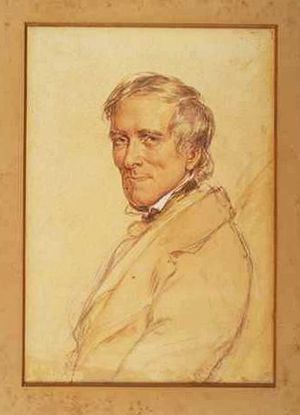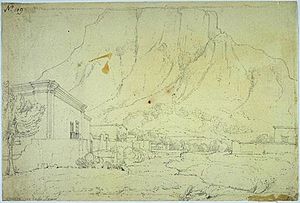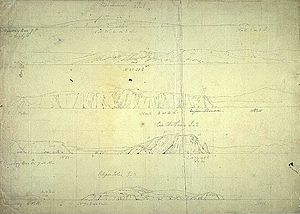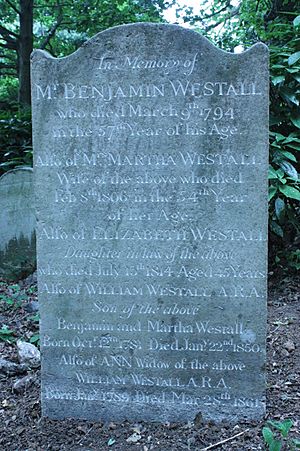William Westall facts for kids
Quick facts for kids
William Westall
|
|
|---|---|

Portrait of William Westall ARA,
by his son Robert Westall, c. 1845. |
|
| Born | 12 October 1781 Hertford, England
|
| Died | 22 January 1850 (aged 68) Hampstead, London
|
| Nationality | English |
| Education | Royal Academy |
| Known for | Landscape art |
| Movement | Picturesque |
William Westall (born October 12, 1781 – died January 22, 1850) was a British landscape artist. He is famous for being one of the first artists to create art in Australia. He was also an Associate of the Royal Academy (ARA).
Contents
Early Life of William Westall
William Westall was born in Hertford, England, and grew up in London. His older half-brother, Richard Westall, was a well-known painter. William loved painting from a young age and wanted to follow in his brother's footsteps. Even though his parents might not have supported this at first, Richard helped William get a good art education. When he was 16, William won an art competition. At 18, he joined the famous Royal Academy, a top art school.
William Westall's Voyages
In 1800, when William was only 19, he was asked by Sir Joseph Banks to join an important trip. He would be the landscape and figure painter for an exploration voyage led by Matthew Flinders. They would sail on the ship HMS Investigator. William was recommended for this job by his fellow student William Daniell and the President of the Royal Academy, Benjamin West.
William Westall joined a team of scientists, including the famous botanist Robert Brown and botanical artist Ferdinand Bauer. This trip became one of the most important scientific expeditions ever.
First Stop: Madeira
The expedition left London on July 18, 1801. Their first stop was Madeira, an island, on August 1. William Westall went ashore with the other scientists to explore. He was excited about the island and worked hard on his sketches.
However, when returning to the ship, their boat was swamped by water. William almost drowned, and all his sketches were lost. This event deeply affected him. He later said that his head was "affected" by the accident. He believed the swamping was done on purpose.
Exploring the Cape Colony
The next stop was Simon's Town in the Cape Colony (now part of South Africa). They stayed there for 18 days. William explored the area, including Devil's Peak and Table Mountain. He was very happy with the beautiful landscapes and made many detailed sketches. Seven of his drawings from the Cape are still around today.
Adventures in Australia
The Investigator reached Australia on December 6, 1801. The next morning, William Westall made his first sketch of Australia, showing the coast near Cape Leeuwin. He made more sketches of islands like Chatham Island (Western Australia) and the Eclipse Islands. They stayed in King George Sound for almost four weeks.
On December 14, William was with Flinders and others when they met an Australian Aborigine for the first time. On December 30, they had friendly meetings with the Aborigines. William sketched an Aboriginal man named Warena. Warena was pleased and helped William by posing for the drawing.
On January 1, 1802, William Westall and Ferdinand Bauer explored together. They discovered the Western Australian Pitcher Plant (Cephalotus follicularis).
Later, William's drawings became fewer and less detailed. Some people think he was disappointed with the Australian landscape because it didn't fit his idea of "picturesque" beauty. Others believe many of his drawings from this time were simply lost.
When the Investigator arrived in Port Jackson (now Sydney) on May 8, 1802, William seemed to get his energy back. During their ten-week stay, he created a lot of art. He drew many detailed pictures of the Hawkesbury River, which he really liked. He also sketched some local Aborigines. The Governor, Phillip Gidley King, asked him to paint Government House. This painting is one of the few William finished during the voyage.
As they sailed north along the east coast, William continued drawing coastal views. In Port Bowen, William won a race to the top of the highest mountain, so it was named Mount Westall. The ship then found a way through the Great Barrier Reef and reached Murray Island. Here, about 50 Torres Strait Islanders came out in canoes to trade. From this point, William started drawing more events and people instead of just landscapes.
His work from this time includes a watercolor called Murray Isles, showing the islanders trading. He also drew The English Company's Islands: Probasso, a Malay Chief, a portrait of a Macassan chief.
William Westall was also the first European artist to draw Aboriginal cave paintings. On January 14, 1803, Flinders' group landed on Chasm Island. Inside rock shelters, they found many painted and stenciled patterns. Flinders asked William to record these images. Flinders wrote in his journal about finding drawings of porpoises, turtles, kangaroos, and human hands. William Westall found a drawing of a kangaroo with 32 people following it.
The Investigator became too old and damaged to continue. Flinders decided to return to England. William Westall joined Flinders as a passenger on HMS Porpoise. On August 17, the ship was wrecked on the Wreck Reefs. The crew and passengers were stuck on a small sandbank for almost three weeks. William made a watercolor called View of Wreck Reef Bank Taken at Low Water: Terra Australia. This was his last drawing of the voyage.
Most of William's drawings were saved from the wreck, though some got wet.
Travels in China and India
William arrived in Canton, China, at the end of 1803. Instead of going straight home, he explored Canton and then sailed to India. He was still being paid by the British government, but he didn't have permission for these extra travels. He wrote a letter to Sir Joseph Banks, complaining about how boring the Australian landscape was. He said he wouldn't have joined the trip if he knew it was only about Australia. The government was not happy and stopped paying him. They told him to find his own way home.
Return to Madeira and Jamaica
William Westall returned to England at the end of 1804. He found out that Flinders was imprisoned on Mauritius. Knowing he wouldn't be asked to work on his sketches for a while, he sailed again to Madeira and then to Jamaica. He finally returned to England in 1806.
William Westall's Art Career
By 1809, the British Navy wanted to show results from Flinders' voyage. Since Flinders was still imprisoned, they asked William Westall to create nine oil paintings of Australian scenes. These paintings took him three years to finish. Some were shown in exhibitions in 1810 and 1812. Because of this, William was elected as an Associate of the Royal Academy.
When Flinders' book, A Voyage to Terra Australis, was being prepared in 1811, William's oil paintings were used as the basis for the engravings in the book. William made sure the paintings were the right size for the book, and then engravers created the plates. The book was published in 1814. Soon after, William published his own collection of these engravings called Views of Australian Scenery.
In 1811, William also published Foreign Scenery, which showed landscapes from Madeira, the Cape of Good Hope, China, and India. This book was a success and led to him working with publisher Rudolf Ackermann. William created many drawings for Ackermann, including views of universities and public schools. He also drew over a hundred pictures for Great Britain Illustrated (1830). He also contributed to other books, like A Picturesque Tour of the River Thames (1828).
Later Life and Legacy
In 1820, William Westall married Ann Sedgwick. They had four sons: William, Thomas, Richard, and Robert. Robert also became an artist. William often felt that he gave up a chance for greater fame to earn a steady income by illustrating books to support his family.
William's health began to get worse in the 1840s. In 1847, he broke his arm and never fully recovered. He found it hard to continue working. His last exhibition was in 1848. He passed away in January 1850, at the age of 68. His grave is in the graveyard of St John-at-Hampstead in north London.
In 1899, William's sons sold 140 of his original drawings from the HMS Investigator voyage to the Royal Colonial Institute. In 1968, these drawings were published as Drawing of William Westall. Later that year, the National Library of Australia bought them.
Review of William Westall's Artwork
William Westall's art from the Investigator voyage has been studied a lot. He made 140 drawings during the trip, which is fewer than the 2000 sketches made by Ferdinand Bauer in the same time. Some of William's drawings also lack detail. He has also been criticized for focusing on people and events in the later part of the trip, instead of just landscapes, which was his main job.
However, his coastal drawings are praised for being very accurate. But in some cases, William changed things in his art. For example, when an Aborigine was shot in the back, William's sketch showed the wound in the chest. His drawing of Wreck Reef showed coral above water, even though it was always underwater.
These changes became even more noticeable when William turned his sketches into oil paintings. He loved the "picturesque" style, which meant making landscapes look ideal. So, he often changed the foreground of his paintings, adding or moving features to make the picture look better. For example, his painting Part of King George Sound uses a completely different foreground, including a Eucalyptus tree he sketched 1800 kilometers away!
William's later work hasn't been studied as much. But his friend, John Landseer, thought William was a better artist than William Hodges and John Webber, who were artists on James Cook's voyages. Landseer believed William didn't get enough recognition because he was a quiet and humble person.
See also
- European and American voyages of scientific exploration









